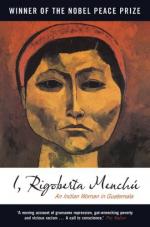|
This section contains 5,164 words (approx. 18 pages at 300 words per page) |

|
SOURCE: Tobar, Hector. “Rigoberta Menchú's Mayan Vision.” Los Angeles Times Magazine (23 January 1994): 16–21, 29–30.
In the following essay, Tobar examines the events in Guatemala that lead to Menchú publishing I, Rigoberta Menchú and her eventual winning of the Nobel Peace Prize.
A society of Indian holy men meets regularly in a Guatemala City apartment to study the Mayan calendar, a 2,500-year-old timekeeping system that is at the center of their religion. In recent years, their reading of the calendar has told them that an ancient prophecy is about to come true: “The time of darkness” is coming to an end. The Mayan people, exploited for five centuries, second-class citizens in their own land, will soon enter an age of “clarity and brightness.” A new dawn is approaching. El nuevo amanecer.
Slowly, inevitably, the priests say, the prophecy is coming true. Ask them for proof and they will tell you...
|
This section contains 5,164 words (approx. 18 pages at 300 words per page) |

|


